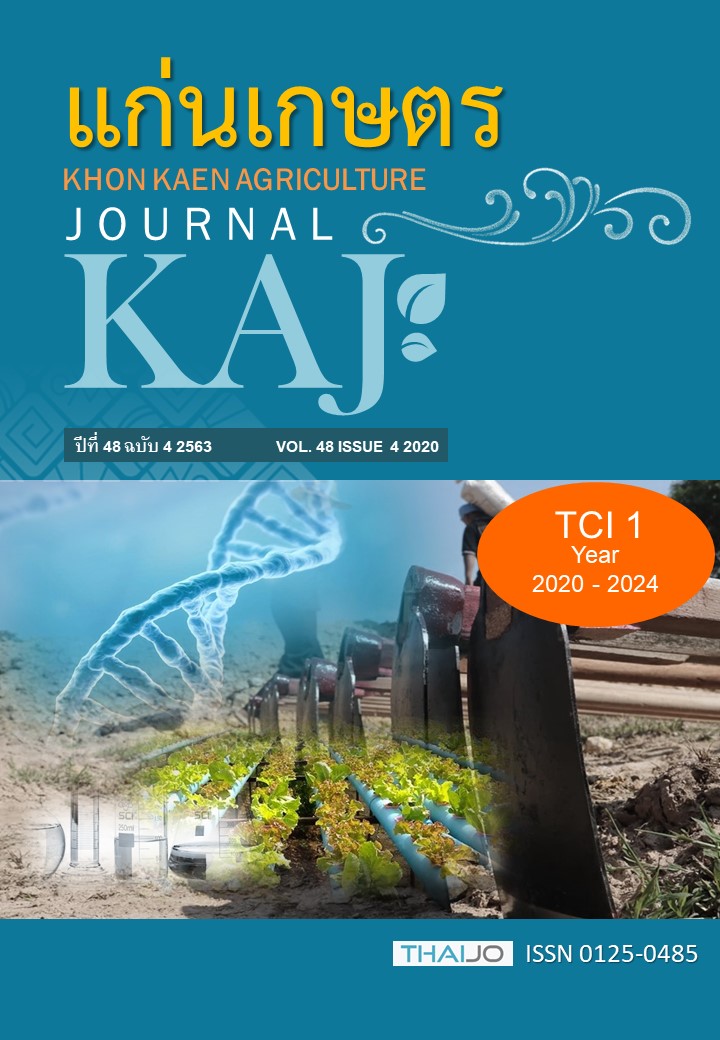การตรวจสอบเชื้อราสาเหตุของโรคกิ่งแห้งของทุเรียน
Main Article Content
บทคัดย่อ
จากความเข้าใจว่าโรคกิ่งแห้งของทุเรียนนั้นเกิดจากเชื้อสาเหตุคือ เชื้อรา Phytophthora palmivora เกษตรกรผู้ปลูกทุเรียนจึงใช้สารเคมีป้องกันกำจัดเชื้อราที่ผิดเป้าหมายมาโดยตลอดเป็นระยะเวลาที่ยาวนาน โรคกิ่งแห้งยังคงเกิดขึ้นในแปลงและส่งผลกระทบให้ทุเรียนใบเหลืองและหลุดร่วงในที่สุด งานวิจัยนี้เพื่อหาสาเหตุของโรคกิ่งแห้งของทุเรียนที่แท้จริง เพื่อหาทางป้องกันการระบาดของโรคนี้ได้ การเก็บตัวอย่างโรคกิ่งแห้ง อาการแผลสีน้ำตาลจากต้น และดิน จากพื้นที่ปลูกทุเรียนในเขตจังหวัดชุมพร จันทบุรี และตราด แยกเชื้อด้วยวิธี tissue transplanting บนอาหารเลี้ยงเชื้อ potato dextrose agar (PDA) และ BNCRA selective medium ได้เชื้อราจำนวน 28 ไอโซเลท จำแนกเชื้อราโดยอาศัยลักษณะทางสัณฐานวิทยา ร่วมกับเทคนิคอณูชีวโมเลกุล พบลำดับนิวคลีโอไทด์บริเวณ ITS1-5.8s-ITS2 และ TEF1-alpha ยาวประมาณ 800 และ 1,000 คู่เบส ตามลำดับ จากการวิเคราะห์ลำดับนิวคลีโอไทด์ จำแนกได้เป็นเชื้อรา Fusarium solani ส่วนการทดสอบความสามารถในการทำให้เกิดโรค โดยการปลูกเชื้อแบบทำแผลและไม่ทำแผลลงบนต้นทุเรียนหมอนทองอายุ 6 เดือน พบว่ากิ่งทุเรียนแสดงอาการเริ่มต้น หลังการปลูกเชื้อ 3 วัน จากการปลูกเชื้อทั้งสองแบบพบอาการแผลแห้งสีน้ำตาลอ่อนเนื้อแผลด้านในสีน้ำตาลอ่อนถึงน้ำตาลเข้ม ใบมีสีเหลือง และหลุดร่วง
Article Details

อนุญาตภายใต้เงื่อนไข Creative Commons Attribution-NonCommercial-NoDerivatives 4.0 International License.
เอกสารอ้างอิง
นิพนธ์ วิสารทานนท์. 2542. โรคทุเรียน. ห้างหุ้นส่วนจำกัด เอ พลัส ทรี มีเดียม, กรุงเทพฯ.
รัติยา พงศ์พิสุทธา. 2535. โรคผลเน่าของทุเรียนหมอนทองที่เกิดจากเชื้อรา Phytophthora palmivora (Butl.) Butl. และการควบคุม. วิทยานิพนธ์ปริญญาวิทยาศาสตร์มหาบัณฑิต มหาวิทยาลัยเกษตรศาสตร์, กรุงเทพฯ.
วีระณีย์ ทองศรี. 2560. โรคตายลามจากยอด (die-back) และโรคราสีชมพู (pink disease) ในทุเรียน. เคหการเกษตร. 41: 89-91.
สมศิริ แสงโชติ, และ ปัญจมา กวางติ๊ด. 2546. การจัดการเชื้อรา Phytophthora palmivora (Butler) Butler สาเหตุโรครากเน่าและผลเน่าของทุเรียนในจังหวัดจันทบุรี. วิทยาศาสตร์เกษตร. 33 (พิเศษ): 45-48.
สำนักงานเศรษฐกิจการเกษตร. 2561. สารสนเทศเศรษฐกิจการเกษตรรายสินค้า ปี 2561. แหล่งข้อมูล: http://www.oae.go.th/assets/portals/1/ebookcategory/38_commodity2561/. ค้นเมื่อ 30 กันยายน 2562.
Bhavakul, K., and V. Jaengsri. 1969. Root rot of durian. P. 60–61. In: Plant Diseases Control. Agricultural Science Society, Bangkok.
Booth, C. 1971. The Genus Fusarium. The Eastern Press Limited, London.
Brasileiro, B.T.R.V., M.R.M. Coimbra, J. M.A. Morais, and N.T. Oliveira. 2004. Genetic variability within Fusarium solani specie as revealed by PCR-fingerprinting based on PCR markers. Braz. J. Microbiol. 35: 205-210.
Demirci, E., and S. Maden. 2006. A severe dieback of box elder (Acer negundo) caused by Fusarium solani (Mart.) Sacc. in Turkey. Australas. Plant Dis. Notes 1: 13-15.
Gebremariam, E.S., D. Sharma-Poudyal, T.C. Paulitz, G. Erginbas-Orakci, A. Karakaya, and A. A. Dababat. 2018. Identity and pathogenicity of Fusarium species associated with crown rot on wheat (Triticum spp.) in Turkey. Eur. J. Plant Pathol. 150: 387–399.
Hoa N.V., D. T. K. Uyen, N. T. Hieu, and N. M. Chau. 2013. A new finding pathogen on durian in south Vietnam and preliminary results on varieties screen against Phytophthora spp. Southern Horticultural Research Institute, Vietnam.
Khanzada, M.A., A.M. Lodhi, and S. Shahzad. 2004. Pathogenicity of Lasiodiplodia theobromae and Fusarium solani on mango. Pak. J. Bot. 36: 181-189.
Kumar, S., G. Stecher, M. Li, C. Knyaz, and K. Tamura. 2018. MEGA X: Molecular Evolutionary Genetics Analysis across computing platforms. Mol. Biol. Evol. 35: 1547-1549.
Kuroda, K., I. Chuma, T. Kihara, T. Murakami, K. Takashina, D. Hiraoka, and N. Kameyama. 2017. First report of Fusarium solani species complex as a causal agent of Erythrina variegata decline and death after gall formation by Quadrastichus erythrinae on Okinawa Island, Japan. J. Gen. Plant Pathol. 83: 344-357.
Lazarotto, M., P.M. Milanesi, M.F. Muniz, L.R. Reiniger, R. Beltrame, R. Harakava, and E. Blume. 2014. Morphological and molecular characterization of Fusarium spp. pathogenic to pecan tree in Brazil. Genet. Mol. Res. 13: 9390-9402.
Leslie, J.F., and B. A. Summerell. 2006. The Fusarium Laboratory Manual. Blackwell Publishing, Hoboken.
Lim, T.K., and S. Sangchote. 2003. Diseases of durian. P. 241–252. In: R. C. Ploetz. Diseases of Tropical Fruit Crops. Cambridge, MA: CABI Publishing, Wallingford.
Nelson, P. E., T. A. Toussoun, and W. F. O. Marasas. 1983. Fusarium species: An Illustrated Manual for Identification. Pennsylvania State University Press, University Park, Pennsylvania.
O’Donnell, K., E. Cigelnik, and H. I. Nirenberg. 1998. Molecular systematics and phylogeography of the Gibberella fujikuroi species complex. Mycologia. 90: 465 –493.
Pongpisutta, R., W. Winyarat, and C. Rattanakreetakul. 2013. RFLP identification of Colletotrichum species isolated from chilli in Thailand. Acta Hortic. 973: 181-186.
Rahjoo, V., J. Zad, M. Javan-Nikkhah, A. M. Gohari, S.M. Okhovvat, M.R. Bihamta, J. Razzaghian, and S.S. Klemsdal. 2008. Morphological and molecular identification of Fusarium isolated from maize ears in Iran. Plant Pathol. 90: 463-468.
Rajput, N.A., M.A. Pathan, M.M. Jiskani, A.Q. Rajput, and R.R. Arain. 2008. Pathogenicity and host range of Fusarium solani (Mart.) Sacc. causing dieback of shisham (Dalbergia sissoo Roxb.). Pak. J. Bot. 40: 2631-2639.
The University of Adelaide. 2016. Mycology Online. Available: https://mycology.adelaide.edu.au/descriptions/ hyphomycetes/fusarium/. Accessed Oct. 2, 2019.
Thompson, A. 1934. A disease of durian tree. Malay. Agric. J. 22: 369–371.
White, T.J., T. Bruns, S. Lee, and J. Taylor. 1990. Amplification and direct sequencing of fungal RNA gene for phylogenetics. P. 315-322. In: M.A. Innis, D.H. Gelfend, J.J. Sninsky, and T.J. White. PCR Protocol: A Guide to Methods and Applications. Academic Press, San Diego.
Zimand, G., L. Valinsky, Y. Elad, I. Chet, and S. Manulis. 1994. Use of RAPD procedure for the identification of Trichoderma stains. Mycol. Res. 98: 531-534.


